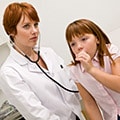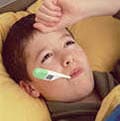- Written by Jennifer King
- Category: Media Releases
From the Centers for Disease Control and PreventionSkin Cancer Prevention
Sun Safety


More Information
- Hits: 2297
- Written by Jennifer King
- Category: Press Room
From the Centers for Disease Control and Prevention (CDC)
Meningitis
 Meningitis is an inflammation (swelling) of the protective membranes covering the brain and spinal cord. A bacterial or viral infection of the fluid surrounding the brain and spinal cord usually causes the swelling. However, injuries, cancer, certain drugs, and other types of infections also can cause meningitis. It is important to know the specific cause of meningitis because the treatment differs depending on the cause.
Meningitis is an inflammation (swelling) of the protective membranes covering the brain and spinal cord. A bacterial or viral infection of the fluid surrounding the brain and spinal cord usually causes the swelling. However, injuries, cancer, certain drugs, and other types of infections also can cause meningitis. It is important to know the specific cause of meningitis because the treatment differs depending on the cause.
Bacterial Meningitis
Meningitis caused by bacteria can be deadly and requires immediate medical attention. Vaccines are available to help protect against some kinds of bacterial meningitis.
Viral Meningitis
Meningitis caused by viruses is serious but often is less severe than bacterial meningitis. People with normal immune systems who get viral meningitis usually get better on their own. There are vaccines to prevent some kinds of viral meningitis.
Fungal Meningitis
Meningitis caused by fungi is rare, but people can get it by inhaling fungal spores from the environment. People with certain medical conditions, like diabetes, cancer, or HIV, are at higher risk of fungal meningitis.
Parasitic Meningitis
Various parasites can cause meningitis or can affect the brain or nervous system in other ways. Overall, parasitic meningitis is much less common than viral and bacterial meningitis. (https://www.cdc.gov/meningitis/parasitic.html)
Amebic Meningitis
Primary amebic meningoencephalitis (PAM) is a rare and devastating infection of the brain caused by Naegleria fowleri. Naegleria fowleri is a free-living microscopic ameba that lives in warm water and soil. (https://www.cdc.gov/meningitis/amebic.html)
Non-Infectious Meningitis
Sometimes cancers, systemic lupus erythematosus (lupus), certain drugs, head injury, and brain surgery can cause meningitis.
How it Spreads
 Bacterial Meningitis
Bacterial Meningitis
Generally, the germs that cause bacterial meningitis spread from one person to another. Certain germs can spread through food. How people spread the germs often depends on the type of bacteria. Read about common examples of how people spread the different types of bacteria to each other.
Viral Meningitis
People can spread the viruses that cause viral meningitis to other people. If you have close contact with someone who has viral meningitis, they may spread the virus to you. However, you are not likely to develop meningitis. That’s because most people infected with these viruses will not develop meningitis.
Meningitis Versus Meningococcal Disease:
There IS a Difference
Having meningitis doesn’t always mean you have meningococcal disease. And having meningococcal disease doesn’t necessarily mean you have meningitis. Meningococcal disease is any illness caused by a type of bacteria called Neisseria meningitidis. These illnesses are serious and include meningitis and bloodstream infections (septicemia). More about meningococcal disease…(https://www.cdc.gov/meningococcal/index.html)
Resources for Healthcare Professionals
Get clinical disease information, as well as vaccine recommendations and vaccination resources, for common causes of meningitis. More >
.
Five College Consortium
The Five College consortium in Massachusetts (MA) is experiencing an outbreak of serogroup B meningococcal disease. The MA Department of Public health recommends vaccination to students at all five schools.
- Learn more from Amherst College.
- Learn more from Hampshire College.
- Learn more from Mount Holyoke College.
- Learn more from Smith College.
- Learn more from UMass Amherst.
Oregon State University
Oregon State University (OSU) has an ongoing outbreak of serogroup B meningococcal disease. Students should check with OSU about requirements to get vaccinated with a serogroup B meningococcal vaccine. Learn more from OSU.
- Hits: 2603
- Written by Jennifer King
- Category: Media Releases
May 13–19, 2018
 It's never too early or late to work toward being your healthiest you! This National Women's Health Week, we want to help you take control of your health.
It's never too early or late to work toward being your healthiest you! This National Women's Health Week, we want to help you take control of your health.Services include:
· Blood pressure and weight evaluation
· Breast and Pelvic Exam, Pap Smear Screening and Referral, if needed
· Breast Self Exam Instruction and Counseling
· Screening, Diagnosis, Treatment and/ or referral for Vaginal Infections, STDs (including HIV)
· Routine Laboratory Testing
· Mammogram Referral
· Pregnancy Testing
· Referral for Perinatal and other Case Management Services
Available Birth Control Methods, including Long-Acting Reversible Contraceptives (LARCs):
· Condoms
· Depo-Provera
· IUD
· Natural Family Planning/Fertility Awareness
· The “Pill”
· The “Patch”
· Referral for Tubal Ligation (Female Sterilization)
· Referral for Vasectomy (Male Sterilization)
· Referral for Emergency Contraception (Plan B)
· Abstinence Counseling
- Hits: 2213
- Written by Jennifer King
- Category: Media Releases
May 9th is National School Nurse Day!
 From handling scraped knees to heartaches and all points in between, local school nurses provide students with much more than just traditional nursing care every day.
From handling scraped knees to heartaches and all points in between, local school nurses provide students with much more than just traditional nursing care every day.
“Mom, social worker, counselor and healthcare provider, put that all together, and you’ve got a school nurse,” said Tammy Keen, MSN, RN, school nurse at Dalton High School. “And no two days are ever the same.”
Renee Smith, RN, supervisor of the school nurse program at Whitfield County Schools, confirmed there is no typical day for a school nurse.
“Every day is different,” Smith said. “Some days you’re giving education to students who come into the clinic with complaints of tummy aches or sore throats or headaches. Other days you see a lot of worried, well students or kids who just want to skip class – those are the easy days.”
Then there are the days when it seems a school nurse is running a “mini-ER”, handling crises that range from serious asthma attacks to dangerous diabetic high blood sugar levels or playground injuries that could involve lacerations or broken bones.
For Traci Hopkins, BSN, RN, supervisor of the school nurse program at Dalton Public Schools and school nurse for Morris Innovative School, a typical day could include anxiety attacks, depression, eating disorders and pregnancies.
“We try to deal with the whole student,” said Hopkins. “We want to support them in staying in school by doing things such as assessing their health condition and helping them get affordable care at our health department and dental clinic, and we help young, new mothers learn how to breastfeed and arrange for child care so they can concentrate on successfully graduating from school.”
 Whitfield County Schools and Dalton Public Schools contract school nurses through the Whitfield County Health Department, which is a unique arrangement in the state of Georgia, since most schools contract nurses through hospitals.
Whitfield County Schools and Dalton Public Schools contract school nurses through the Whitfield County Health Department, which is a unique arrangement in the state of Georgia, since most schools contract nurses through hospitals.
According to Smith, five school nurses serve 13 elementary schools in the county schools, with four of the nurses operating part time in three schools each. Smith serves as a part-time nurse in one school, while supervising the Whitfield County Schools school nurse program. In Whitfield County Schools, each elementary school has a part-time school nurse.
Hopkins said all nine schools in the Dalton Public Schools system have full-time school nurses.
School nurses administer medications and provide hearing, vision and dental screening. They conduct CPR training and educate on healthy lifestyles at health fairs and through one-on-one education with students and parents. School nurses speak individually with students about the impact of risky behaviors such as unprotected sex, tobacco and drug use, and provide referrals, as indicated. School nurses deal with lice, bed bugs and disease outbreaks.
Since school nurses in the two local school systems are public health nurses, they are also able to provide scoliosis screening in the schools. This includes all middle schools throughout the county.
 Keen is grateful the local school nurses program is operated through the county health department.
Keen is grateful the local school nurses program is operated through the county health department.
“Because the program is conducted under public health,” said Keen, “I can look up immunization records. I just looked up one the other day for a student going off to college. I can also pick up the phone and call the nurse practitioner and express concerns about a student’s health and we can work together to provide the care that is needed.
“Many kids in Dalton Public Schools and Whitfield County Schools do not have access to health or dental care. We are their first line of health care. We can assess when the child needs medical or dental care and refer them to the health department, where they usually can be seen the same  day.”
day.”
With the school nurse program under one umbrella in Whitfield County, the nurses are better able to follow through with the students so that if there are health issues that may be acute, they can keep an eye on issues like skin infections or sports-related injuries and make sure students are taking any required medications.
By maintaining relationships with students throughout the school year, especially with children who have chronic conditions such as asthma, diabetes or seizures, these school nurses can work with school staff on educational planning for that child.
“It is a great opportunity to be an advocate for these kids and look at them in a way that nobody else does,” Keen said. “We see the kids through different eyes, so we are an integral part of the academic team, along with teachers, social workers, and counselors – and there we are, all of us working together, helping to support these children in a way that will not only help them be academically successful but successful in life.”
Keen feels it was providential that her years of working with children, adolescents and parents as a nurse practitioner and as a pediatric intensive care clinical nurse specialist, along with her education in nursing, helped prepare her to become a school nurse.
![]() “God was preparing me for this moment and it’s made me a better school nurse,” said Keen. “I’ve had everything from research experience to intensive care training and I’ve worked with adolescents; plus, my nurse practitioner experience has helped me assess the health of children. And, of course, as the mother of teenagers, I’ve had personal experience in dealing with kids!”
“God was preparing me for this moment and it’s made me a better school nurse,” said Keen. “I’ve had everything from research experience to intensive care training and I’ve worked with adolescents; plus, my nurse practitioner experience has helped me assess the health of children. And, of course, as the mother of teenagers, I’ve had personal experience in dealing with kids!”
Steve Bartoo, principal of Dalton High School, said, “Having a full-time school nurse is a great value for our school. Nurse Keen works tirelessly to help develop and support a culture that promotes health and wellness. Not only does Nurse Keen provide a needed service, she has established great relationships with our kids and faculty. There is no doubt in my mind that having a school nurse is a tremendous asset for any school.”
- Hits: 3838










